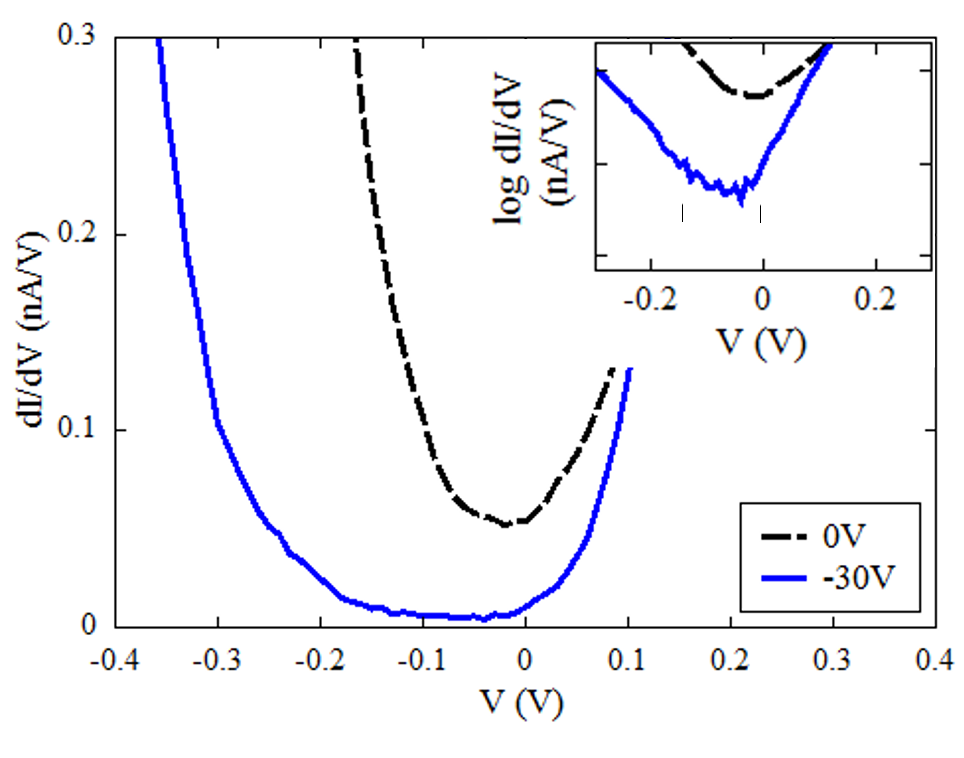Tuning Hydrogen Adsorption on Graphene with Charge Doping
Adsorption of H on graphene has been investigated due to its interest in modification of the electronic properties of graphene and application to H storage. The main issue to realize applications is to control H adsorption/desorption on graphene under ambient conditions. It has been theoretically predicted that the chemical reactivity of graphene to H can be tuned by charge doping. We investigated the influence of charge doping by a gate voltage on the adsorption property of H on graphene, using electric transport measurements and scanning tunneling microscopy/spectroscopy (STM/STS).
Graphene flakes were transferred from exfoliated graphite to a SiO2/Si substrate by scotch tape method, and Au/Ti electrodes were fabricated by electron beam lithography. Atomic H was exposed to graphene with a gate voltage (V_bg) applied in an ultra-high vacuum chamber. From measurements of graphene resistance while sweeping the back gate voltage, the position of the Dirac or charge neutrality point (CNP) was measured. The surface morphology and electronic states of graphene were investigated by STM/STS.
After H exposure, the CNP shifted to the negative side of gate voltage. This corresponds to electron doping from adsorbed H to graphene. The shift of the CNP was larger for graphene with hole doping (V_bg = -30V) than for graphene without (V_bg = 0V) or with electron doping (V_bg = +30V). Figure 1 shows STS spectra after H exposure to graphene with different back gate voltages. A band gap of 0.14 eV was observed after H exposure to graphene with hole doping, while no gap was induced in cases of no doping or electron doping.

Figure 1: STS after H exposure to graphene with V_bg = 0V and -30V in linear scale. Inset: The same spectra in log scale. The vertical bars indicate the positions of the band onsets.
Both the electric transport measurement and STS indicate that more H adsorbs on graphene with hole doping compared to graphene without doping or electron doping. These results demonstrates the possibility to control H adsorption/desorption on graphene via charge doping.
Publications:
- Y. Murata, A. Calzolari, and S. Heun: Tuning hydrogen adsorption on graphene by gate voltage, arXiv:1905.01923 [cond-mat.mes-hall].
- Y. Murata, A. Calzolari, and S. Heun: Tuning hydrogen adsorption on graphene by gate voltage, J. Phys. Chem. C 122 (2018) 11591 (Open Access). [ACS LiveSlides]
Presented at:
- Yuya Murata and Stefan Heun: Tuning Hydrogen Adsorption on Graphene with Charge Doping, The 9th International Workshop on Nanoscale Spectroscopy and Nanotechnology (NSS-9), Gyeongju, S. Korea, 25 – 28 September 2017 (oral). [Abstract] [Talk]
- S. Heun: Hydrogen and graphene: from tuning of hydrogen adsorption by gate voltage, to Si dangling bonds in quasi-free-standing monolayer graphene, McGill University, Montreal, Quebec, Canada (Prof. G. Gervais), 12 July 2018 (invited seminar). [Abstract] [Talk]